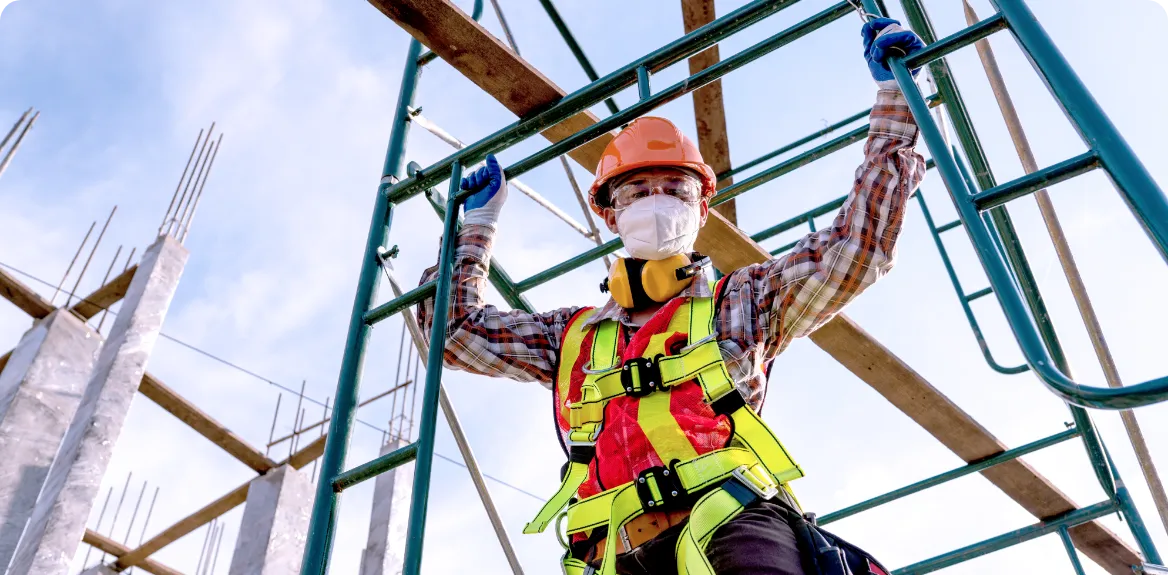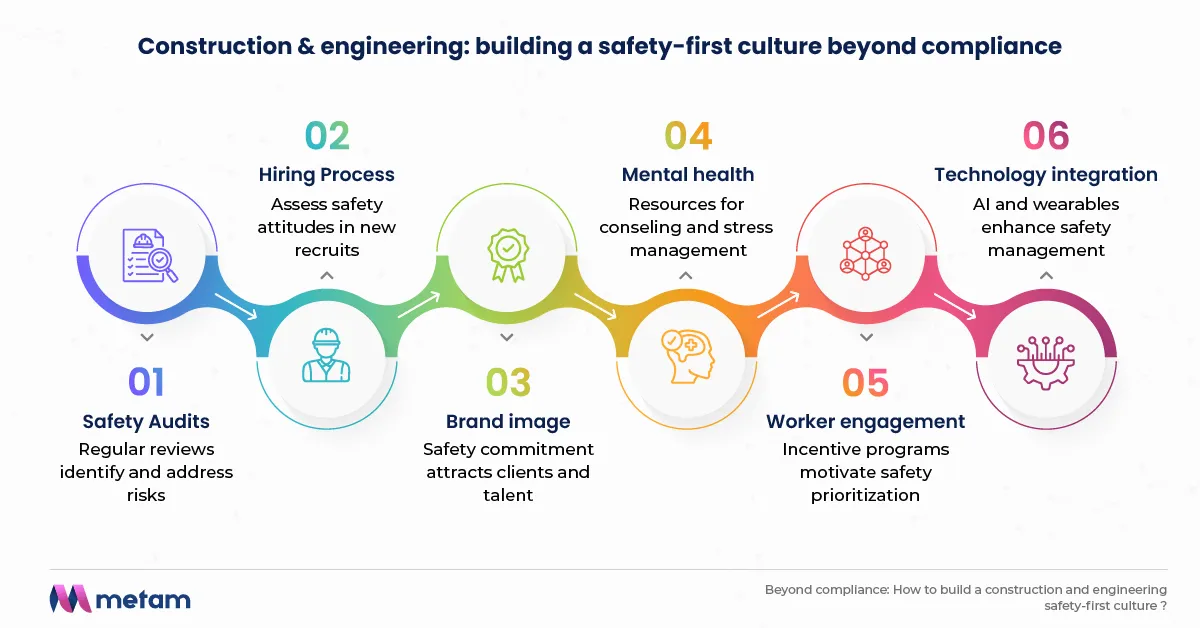
A safety-first culture in construction and engineering goes beyond compliance to create a safer and more efficient work environment. This article covers the essential components, leadership roles, key strategies, and benefits of prioritizing safety at every organizational level.
Building a safety-first culture in the construction and engineering industry goes beyond simply meeting compliance standards; it’s about creating an environment where safety is ingrained in every aspect of the organization.
As the industry evolves, safety leadership must also adapt to new challenges. How can companies lead the way in creating a safety-first culture that ensures compliance while promoting long-term safety improvements?
According to the Occupational Safety and Health Administration (OSHA), 5,333 worker fatalities occurred in the private sector in 2024, with the construction industry accounting for 1 in 5 of those deaths. This stark statistic underscores the need for companies to embrace a culture of safety beyond just compliance to protect workers and improve operational outcomes.
A safety-first culture in construction and engineering is more than just adherence to regulations; it’s an organizational mindset that places the health, safety, and well-being of workers at the core of its daily operations.
This culture goes beyond ticking compliance boxes and actively involves everyone in the company, from senior management to field workers, in creating and maintaining a safe work environment. A genuine safety-first culture integrates safety as a core business value, influencing decision-making processes, operational procedures, and employee behaviors.
Key components include:
Leaders play a crucial role in shaping a safety-first culture. They must actively demonstrate a commitment to safety, not just as a regulatory necessity but as a core organizational value.
Leadership plays a pivotal role in fostering a safety-first culture by setting the tone for the entire organization. Commitment to safety should be visible in every action, from decision-making to resource allocation.
A culture of safety thrives when leadership leads by example, prioritizing safety at every level of operations and encouraging a mindset shift toward seeing safety as a key business value rather than just a regulatory requirement. Companies must also promote accountability among leadership by ensuring that safety performance is regularly reviewed, evaluated, and rewarded.
Empowering workers to take the lead in safety initiatives is essential for embedding a safety-first mindset throughout an organization. Workers who are given the tools, training, and responsibility to take an active role in identifying and mitigating risks are more likely to feel engaged and responsible for the safety culture.
Continual training programs that address both basic and advanced safety skills should be implemented. Additionally, offering ongoing safety workshops or interactive safety drills can keep workers engaged and knowledgeable about best practices.
Open communication is a critical element in fostering a safety-first culture. Companies should establish clear channels through which employees can voice safety concerns without fear of retaliation. Encouraging feedback from all levels, including field workers, helps identify areas for improvement that may otherwise go unnoticed.
Regular safety meetings where employees can discuss issues and solutions further foster a culture of openness and transparency. Ensuring that feedback is acted upon reinforces the idea that safety is everyone’s responsibility.
Leaders who demonstrate a commitment to safety through their actions influence others to do the same. This includes participating in safety training, adhering to safety policies, and making decisions that prioritize safety even when it means facing challenges.
By being actively involved in safety programs, leaders set a strong example and send a clear message to their teams about the company’s safety priorities. Safety-first leadership establishes trust and encourages employees to follow suit, ensuring safety is part of the company’s DNA.
To build a true safety-first culture, companies must integrate safety into their organizational structure. This includes assigning specific safety roles across teams, such as safety officers or safety champions, who are responsible for monitoring safety protocols and encouraging adherence to safety guidelines. Cross-departmental collaboration should be encouraged to ensure safety measures are integrated into every part of the operation, from planning and procurement to project completion.
To fully embed safety into the corporate ethos, it must align with the organization’s values and mission. A safety-first approach should not be seen as a separate initiative but as part of the company’s overarching commitment to quality, excellence, and employee well-being. By embedding safety into the company's core values, businesses ensure that safety remains a priority in every strategic decision, from hiring practices to client relationships.
Building a safety-first culture presents numerous challenges. From overcoming resistance to change to managing the complexities of multinational projects, companies must address multiple obstacles.
Resistance to change is common in industries like construction, where traditional practices have long been the norm. Workers and management may be hesitant to adopt new safety practices, particularly if they believe these changes will disrupt workflow or increase costs.
Overcoming this resistance requires clear communication about the long-term benefits of a safety-first culture, such as reduced injuries, lower insurance costs, and enhanced employee satisfaction. Engaging workers early in the process and addressing their concerns can help minimize pushback.
While investing in safety measures may seem costly, the long-term financial benefits far outweigh the initial investment. Companies must find ways to allocate resources for safety initiatives without sacrificing profitability.
Investing in technology, safety training, and regular audits can lead to fewer accidents, reduced insurance premiums, and higher employee retention rates, ultimately saving money in the long run. Cost-effective strategies include prioritizing safety measures that offer the highest ROI, such as safety training and hazard prevention.
In multinational construction projects, implementing a consistent safety-first culture across various countries can be challenging due to differences in regulations, work practices, and cultural expectations. Companies must adapt their safety protocols to align with local regulations while maintaining global safety standards. Ensuring that safety training is relevant to local contexts and consistently communicating the company’s safety values helps bridge the gap between different regulatory environments.
Contractors and subcontractors are often the backbone of large construction projects, making their engagement in safety initiatives essential. Companies must ensure that contractors are not only aware of but fully committed to the safety-first culture. This can be achieved through safety agreements, joint training programs, and regular performance reviews. Establishing clear expectations from the outset and holding contractors accountable ensures that safety standards are maintained throughout the project lifecycle.
Smaller companies or projects with limited budgets can still prioritize safety by focusing on low-cost, high-impact strategies. Implementing a comprehensive safety training program, promoting awareness through regular safety meetings, and utilizing cost-effective health and safety technology can be done on smaller budgets without sacrificing safety quality. It’s crucial to identify the safety priorities that will provide the most value to the company and its workers.
Fatigue is one of the leading causes of accidents in the construction industry. Addressing worker fatigue and burnout involves creating schedules that allow for adequate rest, monitoring working hours, and offering support for mental health. Programs that address the physical and emotional well-being of workers help reduce the negative impact of fatigue and prevent errors caused by exhaustion, leading to a safer work environment.
Building a truly safety-first culture requires more than meeting regulatory requirements. It involves adopting forward-thinking strategies that prioritize safety across all levels of the organization. Here are key strategies:

A strong safety-first culture yields numerous benefits, including improved worker morale, reduced accidents, and enhanced operational efficiency.
A safety-first culture goes beyond regulatory compliance, fostering an environment where safety is integral to daily operations. Leadership plays a crucial role in instilling and maintaining this culture.
Implementing compliance and safety first technology, offering mental health support, and empowering workers are key strategies for success. Although there are challenges, such as overcoming resistance to change and balancing costs, the benefits far outweigh the initial effort, creating a safer, more efficient, and more profitable work environment.


